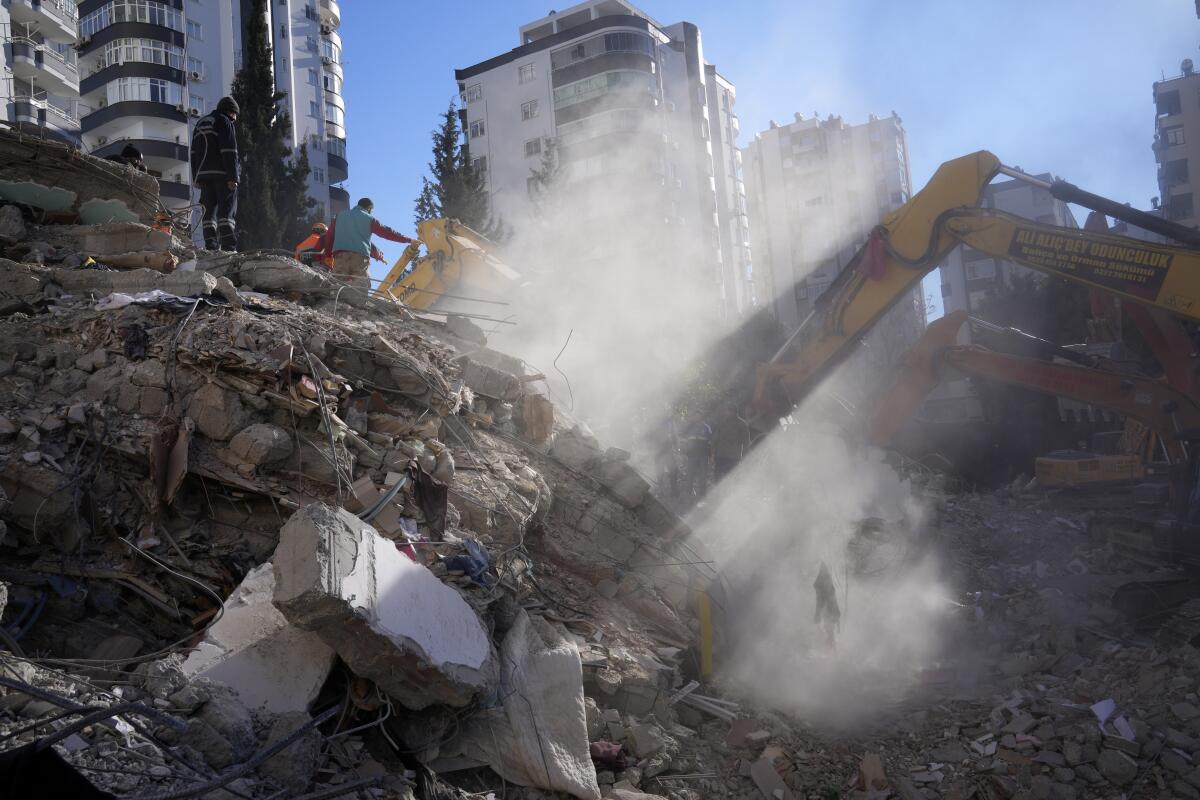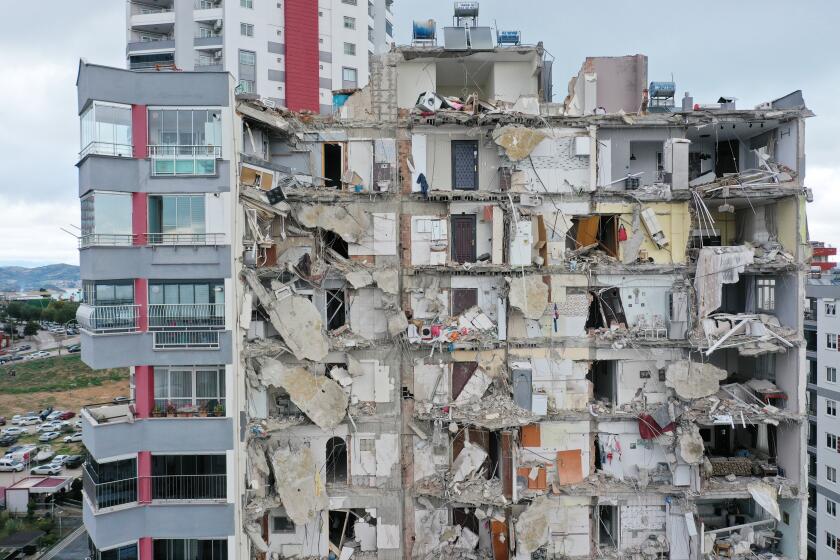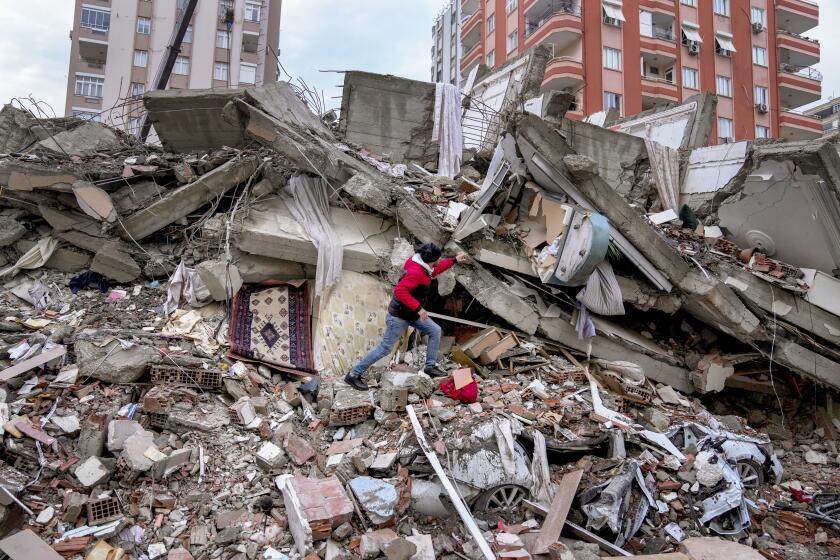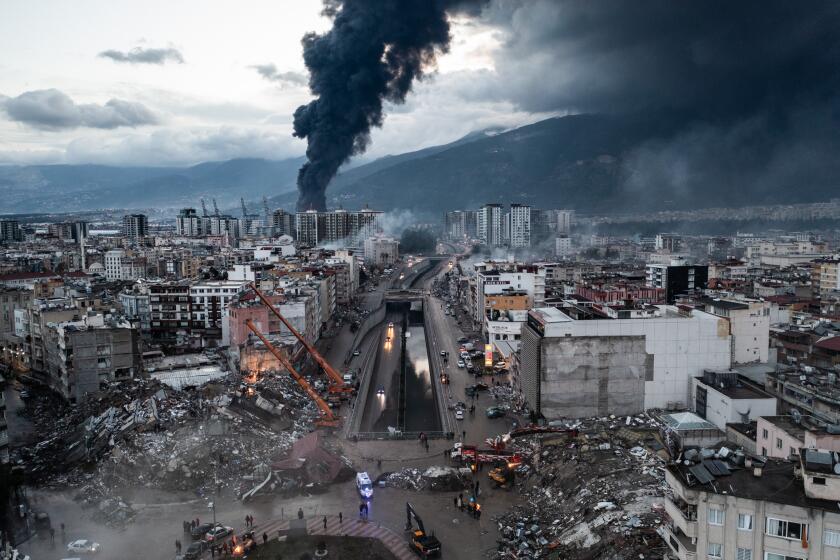Could Turkey’s deadly quakes be followed by more in the Middle East?

- Share via
The fault system that caused this week’s devastating magnitude 7.8 earthquake and 7.5 magnitude aftershock in Turkey has previously triggered other quakes that have affected a broad swath of the Middle East.
It’s impossible to predict future earthquake sequences; pinpointing the exact time and location of devastating quakes ahead of when they hit is the stuff of science fiction. But a general rule of probability is that large earthquakes can beget other earthquakes. Along the fault system that ruptured in Monday’s temblors in Turkey, a quake nearly a thousand years ago was subsequently followed by a sequence of quakes to the south.
The Turkey earthquake occurred on the East Anatolian fault system, which starts on the eastern end of the North Anatolian fault and extends to the southwest, toward the Syrian border, said USC earth sciences professor James Dolan, an expert on Turkey’s fault systems.
Eventually, the system extends southward and becomes the Dead Sea Transform fault system, running through coastal Syria, Lebanon, Israel and Jordan to the Red Sea. Dolan said some of the seismic stresses from Monday’s quakes in Turkey have been transmitted to the northern end of the Dead Sea Transform fault system.
Such a quake would be ‘so powerful that it causes widespread damage and consequently affects lives and livelihoods of all southern Californians,’ a report says.
About 900 years ago, there was a series of large-magnitude earthquakes that propagated from the East Anatolian fault, from north to south. The quakes ruptured the fault in the same area hit Monday. Over the decades, there were half a dozen powerful earthquakes, moving southward on the fault system through coastal Syria into Lebanon, Dolan said, ultimately “culminating in a very large earthquake on the Dead Sea Transform fault system in 1202, mainly centered in Lebanon but extending farther south.”
Earthquakes relieve strain on some faults that has accumulated over many years, decades and centuries. But the stress doesn’t just go away, Dolan said.
“It just gets distributed through the crust onto other faults. And it brings some of those faults closer to a future earthquake. And it moves some of those faults farther away from the future earthquake,” he said. “We saw a classic example of this on Monday where the 7.8 ruptured, and then nine hours later, the stresses that had been released by the 7.8 stressed up another fault ... generating a 7.5 earthquake, which caused many more building collapses and deaths.”
The magnitude of an earthquake isn’t enough to determine how much death and destruction it will cause. Location, time of day, building codes and other factors make a big difference.
Until now, the East Anatolian fault has attracted less attention than the North Anatolian fault, which runs across northern Turkey, from east to west. The North Anatolian fault is dangerously close to the nation’s most populous city of Istanbul. In the early 20th century, a series of large earthquakes began rupturing along the North Anatolian fault, starting with the devastating magnitude 7.8 Erzincan earthquake in 1939 that caused an estimated 32,700 deaths.
The most recent large quakes in that sequence were the magnitude 7.6 Izmit earthquake of August 1999, which struck east of Istanbul and resulted in an estimated 17,000 deaths. It was followed three months later by the magnitude 7.2 Duzce earthquake, which struck farther east.
One section of the North Anatolian fault that hasn’t yet ruptured since then runs close to Istanbul.
A repeat of the 1766 Istanbul earthquakes has long been a fear in the area. A magnitude 7.5 quake close to the city would have devastating consequences for the nation’s cultural and economic hub, which has many more residents than it did more than 250 years ago, Dolan said. Many live in the same type of large multistory “non-ductile” concrete buildings that collapsed in this week’s quakes. Such buildings have an inadequate configuration of steel reinforcing bars, allowing concrete to explode out of columns when shaken.
The East Anatolian fault system has attracted lesser attention, in part because it hasn’t generated devastating earthquakes like the North Anatolian did in the 20th century. The North Anatolian has widely been seen as a major threat: Its mature fault system is smooth, long and straight, which explains its ability to produce mega-quakes as large as magnitude 7.8.
The earthquakes in Turkey show how big quakes are more likely to cause big aftershocks far from the epicenter. The same could happen in California.
One reason the East Anatolian fault may have flown under the threat radar is its propensity for relatively moderate earthquakes. It has mostly been marked by quakes in the magnitude 6.8 to 7.2 range. That is expected, since the East Anatolian is a much younger fault system that’s chopped up, with fault lengths that lend themselves to moderately large quakes, Dolan said.
An example of such a quake occurred in 2020, when the magnitude 6.7 Elazig earthquake struck along a north-central part of the East Anatolian fault, just northeast of the sections that ruptured Monday. There were 41 deaths in that quake.
Based on that historical behavior, there was an assumption that was how the East Anatolian fault system would behave — with modestly large earthquakes, but not supersized ones. “And that was disproven rather shockingly on Monday, when at least four of these different segments ruptured together to generate a truly massive 7.8 earthquake,” Dolan said.
In Southern California, the monstrous San Andreas fault — capable of an earthquake as powerful as magnitude 8.2, according to seismologists — is similar in notoriety to the North Anatolian fault. But there are plenty of smaller, individually named fault systems in the state that could link up to produce a supersized earthquake.
For example, the Hollywood fault could rupture nearly simultaneously to the Santa Monica fault to the west and the Raymond fault — which runs through the San Gabriel Valley — to the east.
Another scenario could combine the Ventura fault with others to cause a magnitude 7.7 to 8.1 quake on faults under the San Fernando Valley, Altadena, Azusa and east to Rancho Cucamonga in San Bernardino County. Another involves a magnitude 7.8 earthquake along a fault system running nearly 70 miles along the coast of Los Angeles and Orange counties, along the Palos Verdes fault zone.
The magnitude 7.3 Landers earthquake, which struck the sparsely populated Mojave Desert in 1992, is one California example that showed just how “faults that we might not think would rupture together can rupture together to generate very large-magnitude earthquakes,” Dolan said.
More to Read
Sign up for Essential California
The most important California stories and recommendations in your inbox every morning.
You may occasionally receive promotional content from the Los Angeles Times.














